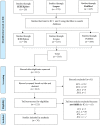On closed-loop brain stimulation systems for improving the quality of life of patients with neurological disorders
- PMID: 37033911
- PMCID: PMC10076878
- DOI: 10.3389/fnhum.2023.1085173
On closed-loop brain stimulation systems for improving the quality of life of patients with neurological disorders
Abstract
Emerging brain technologies have significantly transformed human life in recent decades. For instance, the closed-loop brain-computer interface (BCI) is an advanced software-hardware system that interprets electrical signals from neurons, allowing communication with and control of the environment. The system then transmits these signals as controlled commands and provides feedback to the brain to execute specific tasks. This paper analyzes and presents the latest research on closed-loop BCI that utilizes electric/magnetic stimulation, optogenetic, and sonogenetic techniques. These techniques have demonstrated great potential in improving the quality of life for patients suffering from neurodegenerative or psychiatric diseases. We provide a comprehensive and systematic review of research on the modalities of closed-loop BCI in recent decades. To achieve this, the authors used a set of defined criteria to shortlist studies from well-known research databases into categories of brain stimulation techniques. These categories include deep brain stimulation, transcranial magnetic stimulation, transcranial direct-current stimulation, transcranial alternating-current stimulation, and optogenetics. These techniques have been useful in treating a wide range of disorders, such as Alzheimer's and Parkinson's disease, dementia, and depression. In total, 76 studies were shortlisted and analyzed to illustrate how closed-loop BCI can considerably improve, enhance, and restore specific brain functions. The analysis revealed that literature in the area has not adequately covered closed-loop BCI in the context of cognitive neural prosthetics and implanted neural devices. However, the authors demonstrate that the applications of closed-loop BCI are highly beneficial, and the technology is continually evolving to improve the lives of individuals with various ailments, including those with sensory-motor issues or cognitive deficiencies. By utilizing emerging techniques of stimulation, closed-loop BCI can safely improve patients' cognitive and affective skills, resulting in better healthcare outcomes.
Keywords: brain computer interface (BCI); brain stimulation; closed-loop BCI; neurodegenerative diseases; psychiatric diseases.
Copyright © 2023 Belkacem, Jamil, Khalid and Alnajjar.
Conflict of interest statement
The authors declare that the research was conducted in the absence of any commercial or financial relationships that could be construed as a potential conflict of interest.
Figures







References
-
- Al-Ani T., Trad D., Somerset V. S. (2010). Signal processing and classification approaches for brain-computer interface. Intell. Biosens.25–66. 10.5772/7032 - DOI
-
- Al-Nuaimi F. A., Al-Nuaimi R. J., Al-Dhaheri S. S., Ouhbi S., Belkacem A. N. (2020). Mind drone chasing using EEG-based brain computer interface, in 2020 16th International Conference on Intelligent Environments (IE) (Madrid: IEEE; ), 74–79. 10.1109/IE49459.2020.9154926 - DOI
Publication types
LinkOut - more resources
Full Text Sources

